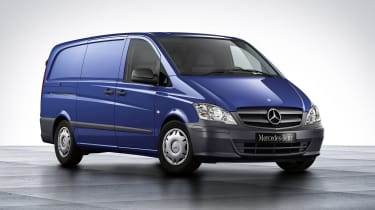Mercedes Vito (2013-2015) van review
The Mercedes Vito is a premium light commercial vehicle with low fuel economy and a great driving experience
The Mercedes Vito stands out in the light commercial market with its premium feel, and that helps it appeal to small businesses more than large fleets. It’s also the only rear-wheel-drive van in the 1-tonne sector. Mercedes offers a range of 2.2-litre four-cylinder (110 CDI, 113 CDI and 116 CDI) and 3.0-litre V6 (122 CDI) diesel engines, plus the option of six-speed manual or automatic gearboxes. Panel van versions of the Vito are available in three lengths – Compact, Long and Extra Long – and with a high-roof option. There’s also a Vito Dualiner crew van with two rows of seats and a Traveliner people carrier version with up to nine seats. Sport and Sport X models are aimed at owner drivers and customers who want to use their van for weekend leisure activities, plus the Vito is a good base for drivers wanting to convert their van into a camper.
MPG, CO2 and Running Costs
For around £630, users can specify the Mercedes BlueEFFICIENCY package on all versions of the Vito – and it’s a good investment. On manual models, this brings an ECO stop-start function, which cuts the engine when the vehicle comes to a halt in neutral; the engine then restarts automatically when the driver dips the clutch to select a gear. Also included is an ECO power-steering pump and an electronically controlled fuel pump – both of which reduce demands on the engine. Regenerative braking sees the alternator and battery management generate electricity when the van is decelerating or braking, low-rolling-resistance tyres reduce drag to cut fuel consumption and a shift indicator on manual models tells the driver when to change up to maximise mpg. As a result of all this, BlueEFFICIENCY vans promise to boost economy by around 2mpg over the standard Vito. So those with the 95bhp version of the 2.2-litre diesel (the 110 CDI, which has replaced the popular 111 CDI) return 37-38mpg, 136bhp 113 CDI versions claim 38-40mpg and the 163bhp 116 CDI four-cylinder promises 38-40mpg. Even the high-performance 122 CDI V6 diesel should achieve 33-34mpg, and that's with an automatic transmission. CO2 emissions range from 193g/km in the cleanest manual BlueEFFICIENCY 95bhp van to 224g/km in the potent V6. Plus, the Mercedes ASSYST set-up ensures a service is only carried out when the Vito needs it – the system calculates service intervals according to how the van has been driven.
Load Space and Practicality
Load volumes in the Vito range from 5.2 cubic metres in the Compact to 5.7 cubic metres in the Long van and 6.2 cubic metres in the Extra Long van. But even the longest version is slightly smaller in the back than some rivals. The standard and long-wheelbase Ford Transit Custom vans manage 5.95 and 6.83 cubic metres respectively, while the high-roof version also has the edge, with 8.29 cubic metres to the Mercedes’ 7.4 cubic metres. It’s a similar story with the Volkswagen Transporter: the regular wheelbase offers 5.8 cubic metres, the LWB model 6.7 cubic metres and the high-roof version 9.3 cubic metres. Drivers choosing the Vito can pick from twin rear doors or a tailgate, with one or two sliding side doors for easy access to the load area. Mercedes also offers a Cargo equipment package, comprising rails integrated into the wooden floor covering, plus moveable tie-down rings to boost flexibility. But all versions of the Vito come as standard with a full-width bulkhead behind the front seats, providing protection from moving loads and reducing noise for the driver. With 1,277mm between the rear wheelarches, it's possible to fit a Europallet sideways in the rear of the van, even in the short-wheelbase Dualiner model. The panel van will hold three Europallets in line. The Dualiner crew van can squeeze in two Europallets behind its three folding and removable rear seats. And while the Traveliner compromises load space for passenger capacity – it’s effectively a small minibus, offering eight seats as standard and nine seats as an option – there’s still a decent amount of room behind the rearmost row of seats. Even though the Vito is rear-wheel drive, the load floor is no higher than rivals’, at 560mm. The Transit Custom has a loading height of 534mm-583mm; the Transporter 566mm-571mm. Plus, the Mercedes can be loaded with a forklift truck from the rear or side, as the back doors fold open out to 180 degrees. The two wheelbases and three body lengths, plus the wide range of engine power outputs, make the Vito suitable for a range of tasks, so it’s popular for everything from inner-city couriers to long-distance deliveries and emergency services.
Reliability and Safety
For years, Mercedes has been setting the safety standard in the van market, and the Vito continues this. It features an adaptive electronic stability programme (ESP) as standard, and takes account of the load on board when activating the anti-lock brake system (ABS), acceleration skid control (ASR) and electronic brakeforce distribution (EBD) system. Disc brakes all round add to the Vito’s safety credentials, while models specified with a factory-fit towbar get ESP trailer stability assist, which uses the van’s brakes to prevent whatever you’re towing from swaying or snaking. As with the larger Mercedes Sprinter van, adaptive brake lights also feature – these flash to warn following drivers when the brake pedal is pushed hard in an emergency stop. A driver’s airbag is standard, with front passenger airbags, window bags and thorax bags offered as options. Rust was an issue with older Vito vans, but this no longer seems to be a problem, and in other respects the Mercedes has a reasonable reputation for reliability. Many engine and electronic components have been proven in the company’s car range, and can be easily replaced if necessary. Plus, the Vito is sold through the Mercedes heavy truck dealer network, so extended hours servicing and repairs – often 24/7 – should be available.
Driving and Performance
The Vito is a comfortable van to drive, and handles well, too. Even the least powerful engines in the 110 CDI and 113 CDI vans deliver decent performance, while the more potent 116 CDI and V6-engined 122 CDI easily keep pace with motorway traffic. Manual gearboxes are light and easy to use, and the Vito is one of the few vans in its class to be offered with an automatic transmission – the most powerful Peugeot Expert gets the option of an auto, and Volkswagen sells its DSG automated manual box on the Transporter, but otherwise you’re largely restricted to a manual. The Vito also stands out in this market with its rear-wheel-drive powertrain. Every rival is front-wheel drive, although the Transporter comes with the option of four-wheel drive. Most owners won’t really notice the difference unless there’s snow on the ground, as the raft of safety kit, like adaptive ESP and ASR, ensures the Vito drives, steers and stops without fuss.
Cab and Interior
Inside, the Vito benefits from durable surfaces, a wipe-clean floor and firm but supportive seats. Visibility is good and, with the gearlever positioned high on the dash, so is cross-cab access. But Mercedes’ foot-operated parking brake can take some getting used to – the release lever is under the right of the dash, which can be tricky to master at first on a hill start. Still, you get a multifunction steering wheel, incorporating controls for the audio equipment, while all the seats feature three-point seatbelts. There’s a long list of options, including electrically adjustable heated door mirrors at £150 and mobile phone integration at £343. But the price can soon spiral, as the extras aren’t especially cheap: ply lining for the load area will set you back £260, Parktronic rear parking sensors are £452 and Tempmatic air-conditioning is £868.



